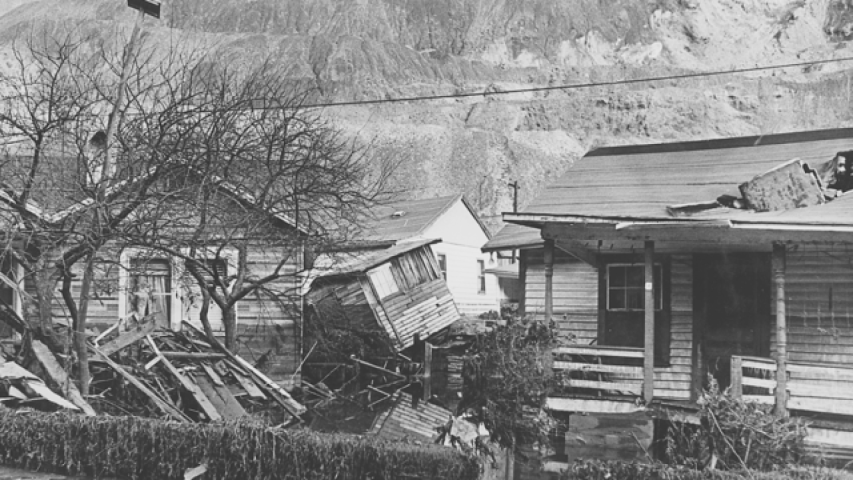
Buffalo Creek Mine Disaster: Feb. 26, 1972
February 26, 2022, marks the 50th anniversary of one of the most devastating mine disasters in U.S. history. Three coal waste dams in West Virginia failed, killing 125 people and injuring 1,100 more in communities downstream of the dams.
Approximately 550 homes were destroyed, and another 900-plus were damaged. Total property damage was estimated at $50 million (about $340 million in 2022 dollars).
What happened?
From 1962 to 1972, three dams were built in on the middle fork of Buffalo Creek in Logan County. Each upstream dam was built several hundred yards upstream of the previous dam. The pool behind Dam No. 1 filled up with fine waste, then Dam No. 2 was built on top of that waste. This process was repeated when the third dam (Dam No. 3) was built over Dam No. 2's slurry pool.
The dams were intended to leak and serve as filters. Black water was pumped into pools behind the dams and dams filtered the deposits so that relatively clear water could run out their downstream face. The dams were not designed or constructed in accordance with then-current engineering standards. Instead, the builders “end-dumped” and shoved loosely compacted layers of coarse refuse across the valley. It was a recipe for disaster as the trio of dams was inadequate to handle runoff from large rainstorms, like the one that dumped several inches of rain on Logan County by early Saturday morning, Feb. 26.
WHAT IS AN
ACRE-FOOT?
300 acre-feet of water would be:
"one acre of area covered by water to a depth of 300 feet", OR
"300 acres of area covered by water a foot deep"
Because of the downpour, nearly 50 acre-feet of fresh water filled the pool of Dam No. 3 above its impounded sediment. The pool was within three feet of the crest of the dam, and ominous cracks appeared. These cracks were a clear indication of the saturation and subsequent destabilization of the structure, but no evacuation order was issued. Dam No. 3 failed at 8 a.m., releasing millions of gallons of water into Dam No. 2.
Dam No. 2 gave way, quickly followed by Dam No. 1. Each failure added millions of gallons to the monstrous wave of water bearing down on the residents of the countryside and towns below.
It took just over 15 minutes. A wave of nearly 130 million gallons of water and other material (a total volume estimated to be between 300 and 400 acre-feet) roared down the Buffalo Creek valley at a velocity estimated to be 20 feet per second in its initial three miles.
The flood wave destroyed houses and mobile homes, uprooted trees, and swept topsoil, huge rocks, trucks and cars downstream. Although its velocity gradually decreased as it traveled down the valley, the event caused death and destruction as far as 15 miles downstream of the dams.
How does MSHA prevent similar disasters?
Immediately following the failure at Buffalo Creek, representatives from the Bureau of Mines and the U.S. Geological Survey formed a task force to study coal waste hazards. The cause of the Buffalo Creek failure was analyzed, an inventory of coal waste impoundments was compiled, and emergency inspections were conducted to identify other potentially hazardous sites. Many coal waste impoundments had to be either modified or closed to eliminate hazardous conditions. This work revealed the inadequacies that existed at that time in the safety of many of the dams constructed by the coal mining industry.
To address this problem, two of the main actions taken by the U.S. Bureau of Mines (the federal mine safety agency at that time, now MSHA) were to strengthen the regulations governing the construction of dams by coal mining companies, and to develop in-house technical expertise on impoundment safety.
Since the impoundment regulations were implemented in 1975, there have been no incidents of dam failures at coal waste impoundments. The goal of MSHA’s impoundment program continues to help ensure that:
- Impoundments constructed by the coal industry are designed to accepted dam safety standards.
- Specific problems, such as the presence of mine workings near impoundments, are dealt with using sound engineering approaches.
- Construction is carried out according to the approved plan.


